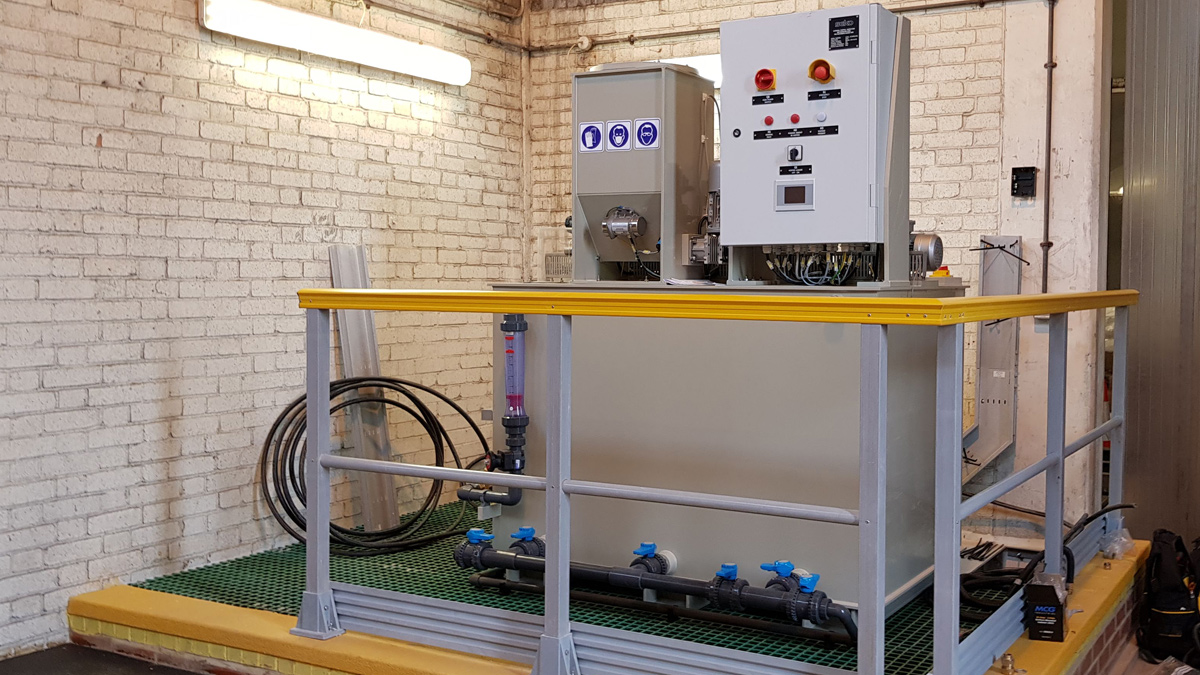Langford WTW (2020)

Ferric dosing cabinets, day tank and safety shower - Courtesy of Essex & Suffolk Water
Langford Water Treatment Works (WTW) is owned and operated by Essex and Suffolk Water (ESW), part of the Northumbrian Water Group (NWG). The treatment works, located near the town of Maldon, treats water abstracted from the nearby River Chelmer and River Blackwater. The river water quality changes greatly with rainfall, at times of excessive turbidity the abstraction of source water is stopped until the water quality returns to within water quality limits. There is bank side storage at Langford to both enable pre-settlement of suspended solids as well as limited storage to enable the WTW to operate in periods when source water abstraction is stopped. In the primary treatment stage of the WTW, clarification and flocculation occur within vertical flow tanks (VFTs), in which polyelectrolyte and ferric sulphate are dosed as a coagulant. Any interruption to either of the coagulation systems will compromise the effectiveness of the VFTs which are the primary barrier for cryptosporidium removal. This is particularly important as Langford is considered a high risk site for cryptosporidium.
Existing processes
Polyelectrolyte is batched by loading powdered product into the hopper at the site batching unit. The unit automatically mixes the powdered poly and service water before decanting into a holding tank within the batching unit. The blended polymer is then used to fill two day tanks located in the basement beneath the batching area. A duty standby dosing pump arrangement next to the day tanks deliver the polymer with service water to a splitter manifold at the vertical flow tanks. This is then distributed to the 6 (No.) VFTs via individual flow indicators capable of having flow switches fitted. The whole system is controlled via a PLC panel located on the ground floor of the chemical building.
The ferric system consisted of 2 (No.) bulk storage tanks refilled by bulk tankers. There are two duty ferric dosing pumps located in the basement of the chemical house drawing directly off whichever bulk tank is manually selected. The ferric sulphate is then dosed via two flash mixers, each one feeding a bank of three VFTs. Control of the ferric system is via the same master panel as the poly system.

Existing poly dosing unit and day tanks – new access stairs and platform – Courtesy of Essex & Suffolk Water
The issues
There were a number of performance issues on both the poly and the ferric dosing systems which had led to significant water quality problems and required frequent human intervention. Both dosing systems did not comply with the NWG Engineering Specifications as they lacked standby assets and reliable instrumentation control and automation components.
At the outset, the project scope was to install a completely new poly dosing system with full SCADA links, but this was revised after the in-house maintenance team had installed instrumentation to improve monitoring of the poly system. The revised project scope focussed on improving parts of the system without having to make a wholesale change. The areas which needed attention were the condition of the batching unit, safe access to the day tank bund area and SCADA communication links.
Meanwhile, NWG have identified that there is greater risk of failure from the ferric system. Whilst the two existing bulk storage tanks are in good working order the ferric dosing element of the system is in poor condition. With the two ferric dosing pumps operating 24-hours a day without a standby unit, failure of a pump would significantly reduce the WTW throughput. Also, the quality of the ferric sulphate from the supplier has been varied and has caused blockages in the suction pipework and strainer. This problem was compounded by the lack of an intermediate storage facility, i.e. a day tank between the bulk storage and the dosing pumps. There was an urgent need to resolve the standby pump and the transfer issues.
Solution
The adopted solution comprised the following:
- On the polyelectrolyte dosing system, it was decided to install a new batching unit capable of producing 550 litres of polyelectrolyte per hour. This new unit is to take the place of the old standby unit which would have required significant work to restore to fully serviceable condition. The new unit is to be setup to provide operational status, levels and alarms to the existing SCADA. The original duty batching unit is to be retained as an emergency back-up unit, after being cleaned and serviced.
- The original dosing pumps and day tanks are to be retained but access to the tank bund is to be improved with new access steps, handrail and mesh flooring.
- Replacement of the actuated valves on the poly day tanks to the newer type where the valve is not disengaged from the actuator if manually operated.
- To enhance the monitoring system, flow switches are to be installed so that dosing to each of the VFTs can be confirmed and alarmed on SCADA.

Ferric transfer pumps and local control panel – Courtesy of Essex & Suffolk Water
- On the ferric dosing system, the changes required are more extensive. This consisted of new duty/standby transfer pumps in the basement of the chemical building near to the bulk tanks, so as to keep suction pipework to a minimum. The pipework, valves and strainers arrangement is to allow ferric to be drawn from either bulk tank. The transfer pumps are to be auto changeover on pump fault and strainer blockage and are arranged so the transfer of ferric can continue while the faulty pump or blocked strainers are being maintained.
- Ferric is transferred from the basement to a new bunded day tank which has a 3000 litres effective capacity. This will provide a minimum of 24-hour storage to allow any problem in the transfer system to be resolved. The transfer pump control panel will monitor the day tank level as well as the pump status and strainer blockage. All the signals will be feedback to the PLC in the existing master panel.
- Each new pump is to be able to dose between 5 mg/l and 14 mg/l, at a flow rate between 30 to 100 litres per hour. The design is to allow the standby pump and associated valves to be automatically run at regular intervals to prevent blockages.
- The day tank and three new ferric dosing pumps (duty/duty/standby) are all to be located at the ground floor of the chemical house, for ease of access.
- New dual containment pipework and flow meters are required on both delivery lines.

Strainer units on the poly transfer system – Courtesy of Essex & Suffolk Water
Project delivery
An ECC Option A Design & Construct contract was awarded to NWG chemical dosing framework supplier Aquazone Ltd to deliver the above-mentioned scope of works. In summary, the works comprised:
- A new ferric dosing system to include additional transfer system and day tank storage.
- Partial upgrade of the poly system with a new preparation/batching unit along with the safe access and instrumentation enhancements.
Aquazone’s detail design work involved developing the concept and control philosophy provided by NWG to provide full working drawings and specifications for construction.
Key process units were manufactured off site. The ferric transfer and dosing cabinets which were assembled in Aquazone’s workshop. The poly batching unit, the 3000 litres ferric day tank and emergency shower unit were delivered to Aquazone by their suppliers. Following successful testing of the components’ integrity and the installed software, the units were then transported to site by Aquazone.
Apart for a single short outage on the ferric supply required for the final connection to the new system, there was no interruption to the WTW operations throughout the whole of the construction period.
The final part of the commissioning work was carried out in April 2020, after the onset of the Coronavirus Covid-19 pandemic. Special site operating procedures were introduced by both NWG and their suppliers to ensure the workforce and staff were protected and the risk of spreading infection was minimised. After an initial pause to ensure all the necessary measures were able to be implemented, both systems were fully commissioned. Both systems then underwent a 28-day performance trial period to demonstrate their reliability. During this period, some minor adjustments were allowed, and modifications made to improve the operability, but on the whole no defects were notified.
Site Safety Inspections were carried out on a regular basis by Aquazone’s safety Manager and the reports were submitted to the NWG Project Manager.

Two of the three ferric dosing cabinets and the common outlet pipe section – Courtesy of Essex & Suffolk Water
Langford WTW Dosing Systems supply chain: Key participants
- Client: Essex & Suffolk Water
- Principal designer: Aquazone Ltd
- Principal contractor: Aquazone Ltd
- Systems integration: OCE Systems
- Polymer preparation/batching unit: SEKO
- Ferric day tank: Forbes Technologies
- GRP flooring specialist: Step On Safety
Experience and performance to date
Through close working and active participation from NWG capital planning, water quality, asset investment, the site owner and operators, significant efficiency savings were achieved. One of the key decisions made was not to replace the whole of the poly dosing system and just to target specific elements of this system. The team subsequently recognised that there is greater risk of failure on the ferric dosing and went on to develop the concept design for a whole new ferric system. This then allowed the works required for both systems to be packaged for delivery under a single contract.

Poly preparation/batching unit – Courtesy of Essex & Suffolk Water
Benefits of off-site manufacture of the ferric transfer and dosing pump units enabled the work to be carried out in a controlled environment which allows better quality control as well as reducing number of site activities, duration and working areas. All these factors contributed to reducing the impact on NWG operations, and above all the health and safety risks.
Although neither the site activities nor the interface with NWG operational activities were extensive, there was still collaborative working between the NWG project engineer, the NWG operational team and the contractor which contributed hugely to the successful delivery of the works.
Under Covid-19 restrictions, a training video will be made on site with a single participant and this video will then be put online to train the rest of the operations and maintenance team.




